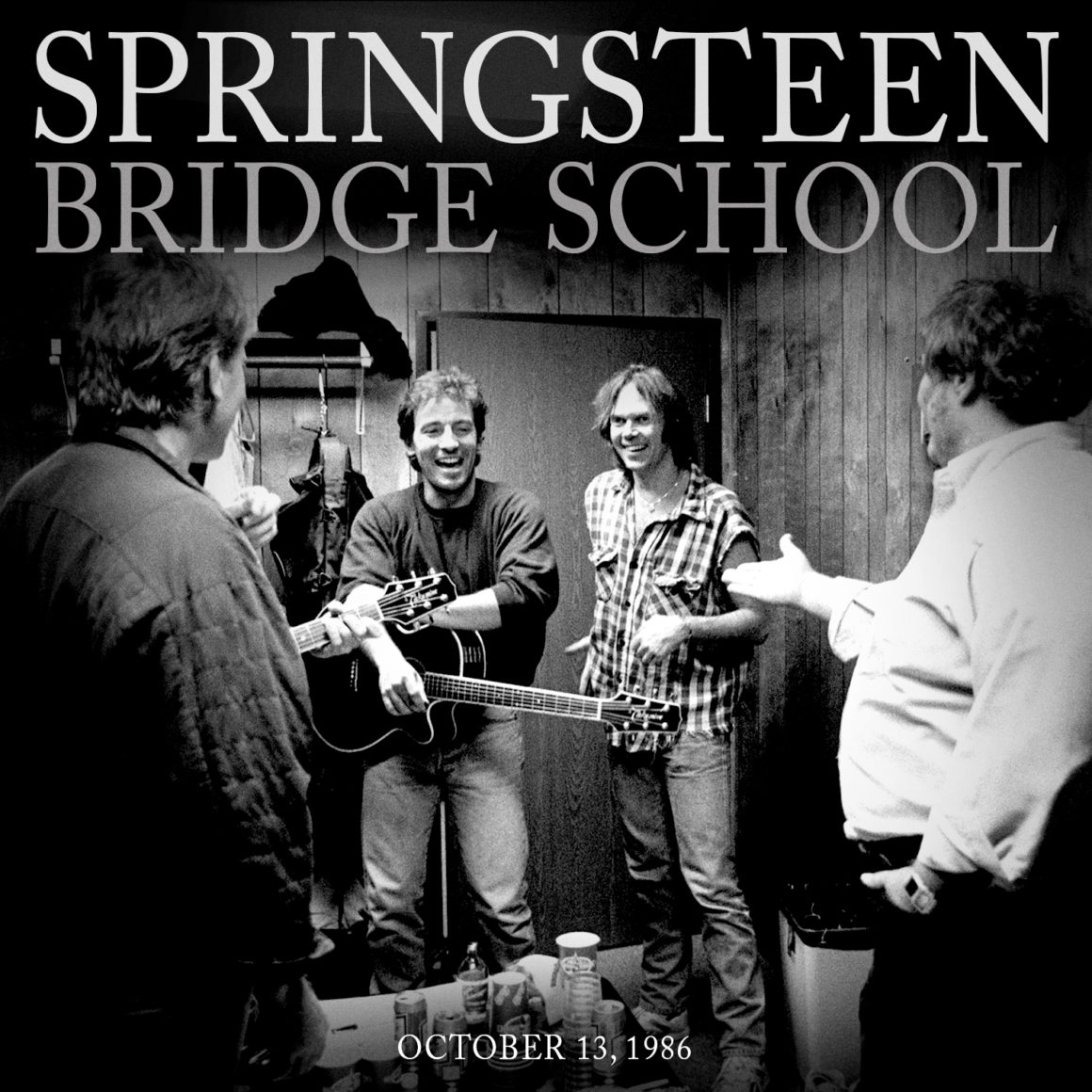
Bruce Springsteen feat. Danny Federici and Nils Lofgren
Shoreline Amphitheatre, Mountain View, CA, October 13, 1986
By Erik Flannigan
Less than a month before the release of his physically and sonically mega box set Live/1975-85, Bruce went completely the opposite direction, stripping down to play his first all-acoustic set since 1972 at what would become Neil Young’s annual Bridge School Benefit Concert.
During a guest DJ session on E Street Radio, Nils Lofgren recounted getting a call from Bruce to join him for the Bridge (Lofgren was also on the bill as a solo artist). Along with Danny Federici, the trio worked up and rehearsed the set in a New York City studio in early October 1986. But as Nils tells it, in an anecdote that conveys deep admiration for the confidence and prowess of his bandleader, on show day at Shoreline, Bruce called a major setlist audible. It wouldn’t be enough to merely play acoustic; Springsteen would go one step further and open the show a capella.
Here was the biggest rock star in the world, last seen 12 months earlier wrapping his staggeringly successful Born in the U.S.A. tour in front of 85,000 fans at the LA Coliseum, taking the stage and singing “You Can Look (But You Better Not Touch)” accompanied only by his snapping fingers. Nils described Bruce’s audacious performance as Elvis-like in its physicality, and grainy bootleg video of the show confirms that. What an entrance.
The Bridge ’86 is a special show. The short but oh-so-sweet set reconnected Springsteen with acoustic performance and can be viewed in hindsight as helping spur a decade or more of solo appearances like the Christic concerts and acoustic recordings like The Ghost of Tom Joad that followed.
The line-up for the inaugural Bridge benefit included Bruce, Nils, Don Henley, Robin Williams (who briefly referenced his famous “Elmer Fudd does Bruce Springsteen” bit during his stand-up set that night), Tom Petty, and host Neil Young (who had his own special guests in Crosby, Stills & Nash). Not unlike the M.U.S.E./No Nukes shows, another benefit where some of these same artists shared a bill, “Broocing” throughout the concert made it clear who most of the audience had come to see.
Following “You Can Look,” Bruce delivers an astounding rebuttal to the jingoistic appropriation that surrounded the title track of his last album. “This is a song about the snake that came around and began to eat its tail,” Bruce says introducing his first public airing of the original solo acoustic arrangement of “Born in the U.S.A.” Any misconstruing of or ambiguity as to the song’s meaning is vanquished over the next five minutes in a spellbinding performance. Until the Bridge, one could only speculate as to what “Born in the U.S.A.” would have sounded like on Nebraska. Now we know.
Nils and Danny then take the stage, and we get an exquisitely rare outing for this E Street Trio. What magic they weave. “Seeds” arrives as a companion to “Born in the U.S.A.” Angry and defiant in 1985, the 1986 model of “Seeds” is instead weary and knowing, sounding like a tune from a bygone era. “Darlington County” is next, preceded by a mini-edition of the story that introduced “Open All Night” in 1984 of Bruce getting pulled over on the turnpike. Nils provides charming harmony vocals throughout the show, none better than what he offers here, as “Darlington” takes its time driving down from New York City.
Strumming and singing brightly, Lofgren shines again on “Mansion on the Hill,” as does Federici. Danny first vamps a little “Lady of Spain,” as Bruce gets his guitar ready, then adds rich accordion swells that paint the song an emotionally tinged hue.
“Fire” will be familiar to those who own Video Anthology on VHS or DVD, where the Bridge version was showcased. Before it starts, Danny is again tapped to fill time due to minor technical difficulties, and he drops a dose of Duke Ellington’s “Satin Doll.” Uncannily, Federici used the song in much the same manner in the earliest E Street days circa 1973-74. Though “Fire” is rightly remembered as a Clarence Clemons showcase, the acoustic version, carried by Bruce’s deep vocal, is pure delight, peaking when Lofgren and Springsteen raise their voices way up to sing, “your words they liiiiiie.”
“Dancing in the Dark” rides a particularly passionate lead vocal along with some fine accordion work from Federici in the final third that pushes the Shoreline audience towards rapture. “Glory Days” always had a bit of a campfire singalong vibe underneath it, and that comes through in this charming take that has the swooning audience joining in.
Serving as something of an encore, “Follow That Dream” lends poignancy to the evening as Springsteen dedicates the song to Neil and Pegi Young. In its River tour incarnation (as heard on the London ’81 archive release) “Follow That Dream” is stark and solemn. In 1986, it transforms into an uplifting song of hope, performed less as a mediation and more as an instruction.
For the final song of the set, “Hungry Heart,” the trio is expanded with backing vocals and guitar from special guests David Crosby, Graham Nash, Stephen Stills, and Young, putting a spirited ending on just under an hour of acoustic enchantment.
Bridge School ’86 is a significant moment in the rebirth Springsteen as an acoustic artist. Since that show, Bruce has done two fully acoustic tours and a Broadway run that carried on in the spirit of ’86. Perhaps someday, Bridge School ’86 could still inspire an E Street Trio tour as well.